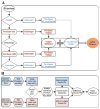Prediction of chemotherapeutic response in bladder cancer using K-means clustering of dynamic contrast-enhanced (DCE)-MRI pharmacokinetic parameters
- PMID: 24943272
- PMCID: PMC4298475
- DOI: 10.1002/jmri.24663
Prediction of chemotherapeutic response in bladder cancer using K-means clustering of dynamic contrast-enhanced (DCE)-MRI pharmacokinetic parameters
Abstract
Purpose: To apply k-means clustering of two pharmacokinetic parameters derived from 3T dynamic contrast-enhanced magnetic resonance imaging (DCE-MRI) to predict the chemotherapeutic response in bladder cancer at the mid-cycle timepoint.
Materials and methods: With the predetermined number of three clusters, k-means clustering was performed on nondimensionalized Amp and kep estimates of each bladder tumor. Three cluster volume fractions (VFs) were calculated for each tumor at baseline and mid-cycle. The changes of three cluster VFs from baseline to mid-cycle were correlated with the tumor's chemotherapeutic response. Receiver-operating-characteristics curve analysis was used to evaluate the performance of each cluster VF change as a biomarker of chemotherapeutic response in bladder cancer.
Results: The k-means clustering partitioned each bladder tumor into cluster 1 (low kep and low Amp), cluster 2 (low kep and high Amp), cluster 3 (high kep and low Amp). The changes of all three cluster VFs were found to be associated with bladder tumor response to chemotherapy. The VF change of cluster 2 presented with the highest area-under-the-curve value (0.96) and the highest sensitivity/specificity/accuracy (96%/100%/97%) with a selected cutoff value.
Conclusion: The k-means clustering of the two DCE-MRI pharmacokinetic parameters can characterize the complex microcirculatory changes within a bladder tumor to enable early prediction of the tumor's chemotherapeutic response.
Keywords: bladder cancer; chemotherapeutic response; k-means clustering; pharmacokinetic parameters.
© 2014 Wiley Periodicals, Inc.
Figures






References
-
- Griffiths TR. Current perspectives in bladder cancer management. Int J Clin Pract. 2013;67:435–448. - PubMed
-
- Barentsz JO, Berger-Hartog O, Witjes JA, et al. Evaluation of chemotherapy in advanced urinary bladder cancer with fast dynamic contrast-enhanced MR imaging. Radiology. 1998;207:791–797. - PubMed
-
- Dobson MJ, Carrington BM, Collins CD, et al. The assessment of irradiated bladder carcinoma using dynamic contrast-enhanced MR imaging. Clin Radiol. 2001;56:94–98. - PubMed
Publication types
MeSH terms
Substances
Grants and funding
LinkOut - more resources
Full Text Sources
Other Literature Sources
Medical

